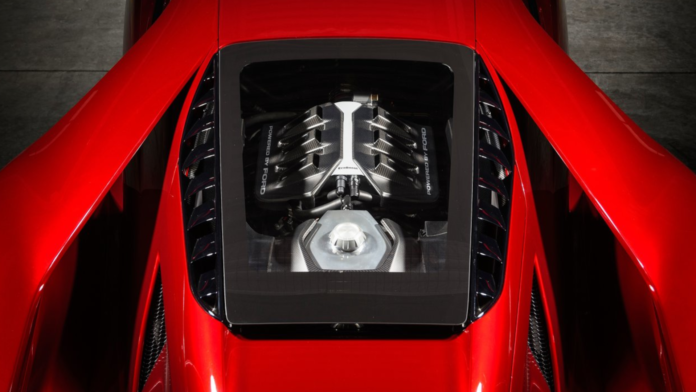Ford has a long-standing reputation for producing powerful large-displacement V8 engines, commonly found in sports cars, pickups, and heavy-duty vehicles. However, as global emissions regulations have tightened over the years, manufacturers have been compelled to adapt by scaling down these formidable engines. This shift prompted the development of Ford’s EcoBoost engine series, designed to provide power and torque outputs comparable to naturally aspirated engines with larger displacements, while using less fuel and emitting fewer harmful pollutants.
Related
The 10 Most Powerful Versions Of Ford’s Modular V8 Engine
Ford’s modular V8 engine is omnipresent within its ranks and has been for years. Here are the most powerful models to ever used the modular V8 enigne.
The EcoBoost engine family consists of gasoline engines built primarily from lightweight aluminum. These modern engines feature direct injection, dual overhead camshafts, and forced air induction. The EcoBoost engines are available in three-, four-, and six-cylinder configurations with various displacements. Meticulously designed to be a more eco-friendly oil burner, and also more cost-effective to manufacture than hybrid or diesel powertrains. These magnificent engines continue to be employed across a variety of Ford motor vehicles today as they align with global emissions standards.
The information for this article was sourced from Ford.
EcoBoost Engine Origins
- The V6 EcoBoost is used in the Ford GT from 2017 to 2020.
- The 4-cylinder EcoBoost engine is used in the Ford Fiesta ST 200.
- The 3-cylinder EcoBoost engine is used in the Ford Puma ST.
The EcoBoost engine was first introduced in 2009 at the Cleveland Engine Plant No. 1. This 3.5-liter V6 twin-turbo gasoline engine utilized a Duratec 35 engine block and featured a high-flow direct injection fueling system. It was initially installed in the all-wheel-drive fourth-generation Ford Taurus SHO and the 2010 Lincoln MKT. Equipped with twin Garrett GT1549L turbochargers, it produces 365 hp at 5500 rpm and 350 lb-ft of torque.
In its first year, 14,439 EcoBoost engines were manufactured. The Ford EcoBoost family expanded to include a variety of engines, ranging from a 1.0-liter 3-cylinder to 1.5-liter, 1.6-liter, 2.0-liter, and 2.3-liter 4-cylinder engines, as well as the powerful 2.7-liter and 3.5-liter V6 engines. Among these, the 3.5-liter V6 stands out as the most powerful unit in the series, designed to replace the larger 5.4-liter V8 from the first-generation Ford GT, all while promoting better fuel efficiency and lower emissions.
This turbocharged V6 was further developed for the second-generation 2018 Ford GT, achieving an impressive 647 hp at 6,250 rpm and 550 lb-ft of torque at 5,900 rpm. A tuned-down version also powers the F-150 Raptor, along with a less powerful variant for the standard F-150. The new engine technology not only delivered performance on par with the V8 it replaced but also met expectations for improved fuel economy and reduced pollutants.
Most Powerful Version And Application
|
Car model |
2023 Ford GT Mk IV |
|---|---|
|
Engine power |
820 hp |
|
Engine torque |
Not Provided |
|
0-60mph |
Not Provided |
The second generation Ford GT was introduced in 2015 and employs the most powerful version of the 3.5L V6 twin turbo EcoBoost engine which shares the same engine block, cylinder head and its dual fuel system as the popular F-150 pickup truck. It is, however, equipped with a larger turbocharger, an aluminum intake manifold, a dry sump, more aggressive camshaft profiling, and reinforced timing drive components for a more efficient valve mechanism.
The pistons are slotted into 92.51 mm x 86.7 mm, bore x stroke cylinders, and are made of cast aluminum, while the con-rods are fully machine-forged steel. As with EcoBoost engines, it features double overhead camshafts, four valves per cylinder with twin-independent variable camshaft timing and low-friction roller-finger-follower rocker arms. Power is sent to the rear wheels of the GT via a 7-speed automatic dual-clutch transmission box, propelling the unit from 0-60 mph in 3.0 seconds. Top speed peaks at 216 mph. The No. 68 Ford GT was crowned the overall winner of the 2016 LeMans 24 Hour endurance race.

Add CarBuzz to your Google News feed.
In 2020, engineers fiddled some more, adding gallery cooled pistons and more powerful ignition coils, together with new ECU tuning. The resulting power output figures clocked 660 hp at 6,250 rpm with the torque figures unchanged. New tuning resulted in a broader torque band for more efficient power delivery with less engine stress. New 0-60 mph times were recorded at just 2.8 seconds. Engine cooling and airflow have been doubled thanks to the buttress air duct design, and larger intercoolers regulate air temperatures more efficiently. An Akrapovič titanium exhaust system is fitted standard, reducing 9 lbs weight over the previous system, while proving a pleasant tone. The 2020 GT came with two exterior options: Liquid Carbon that featured a carbon fiber body, or a re-styled Gulf Racing Heritage livery that pays homage to Ford’s GT40 1969 Le Mans win.
In 2023, Ford unveiled the most powerful version, which is the GT Mk IV. There is one caveat, however. The GT Mk IV is not road legal, and while it looked like a Ford GT, it has very little in common. It had a full Multimatic Adaptive Spool Valve suspension and a long-tail carbon fiber body. It also cost $1.7 million, which was more than three times the price of the standard car. To get to 800 horses, the engine also had to be enlarged, though those and many other details were never shared.

Related
Ford GT Mk IV Smashes Circuit Of The Americas Lap Record
The track weapon set an unofficial record of 1:58.77 seconds.
Other Notable EcoBoost Performance Applications
Other notable cars that utilize the Ecoboost engine technology are found in the current Ford Puma ST Powershift. It employs the 3-cylinder 1.5-liter Ecoboost Dragon engine that produces 200 hp at 6,000 rpm and 210lb⋅ft of torque from 1,600 to 4,000 rpm and features cylinder deactivation technology. It was first fitted in the 2018 Ford Fiesta ST and kept in rotation until 2023. In other markets, the 2013-2017 Fiesta was also fitted with the 4-cylinder 1.6-liter Ecoboost engine that produced 197 hp.
A 2.0L model of the EcoBoost engine that developed 252 hp at 5500 rpm and 270 lb-ft at 2000-4500 rpm was used in the 2012-2018 Ford Focus ST and a more powerful version of the engine was used in the 2011 Radical SR3 SL racing car. In 2015, a 2.3-liter version of the Ecoboost made its first appearance in the 2015 Ford Mustang, which featured new twin scroll turbochargers. The engine produced 310 hp at 5,500 rpm and 350 lb⋅ft at 3000 rpm for that generation. Later, it was dialed up to 315 hp with the same torque output. A more powerful version was deployed in the 2016-2918 Ford Focus RS and an even more potent version in the 2017 Dallara Stradale sports car – 395 hp and 369 lb.ft.

